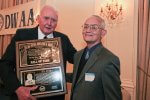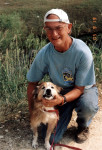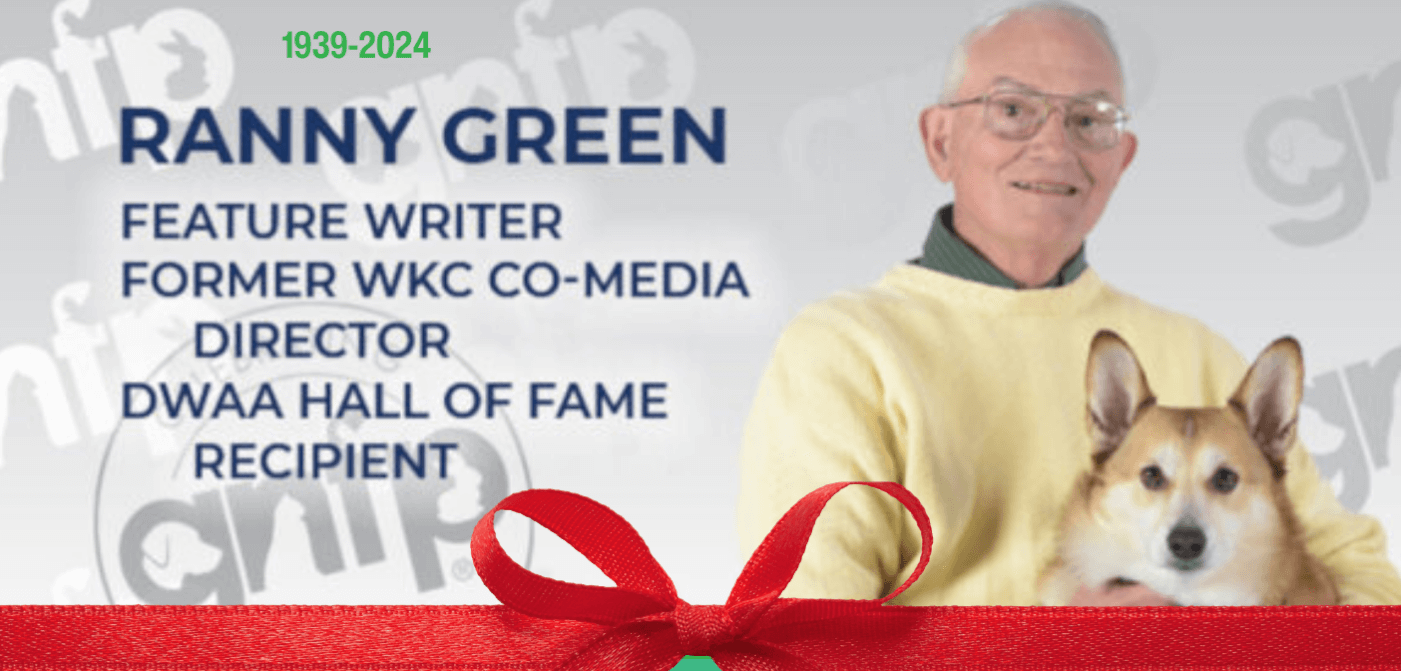In Tribute: Ranny Green (1939-2024)
Today, family and friends pay tribute to Ranny Green at a memorial service in Seattle. Ranny passed away in September after a long illness. Since we can’t be there we are paying our respects online. Although you can read my blog post, this interview captures his essence far greater — in his own words. Rest in peace, Ranny. There will not be another like you.
(Originally posted April 28, 2023)
If there’s a story behind the story, Ranny Green will find it. Ask him how the story came about and he’ll just as easily give the dog and another human the credit. As an example, his latest book review turned into a feature as he lauded author Dr. Karen Levin and paid tribute to his beloved dog Maggie who recently passed over the rainbow bridge.
Humility is Ranny’s calling card. He has been a reporter and has written for over four decades, including for Goodnewsforpets.com. That’s why he was interviewed for the Goodnewsforpets.com 20th Anniversary — and why we’ve updated it here for Germinder & Associates‘ 25th Anniversary. Ranny covered the news angles of many of our client stories while he was a reporter at the Seattle Times. We worked with him when he was handling press room queries at the Westminster Kennel Club Show press room. We say a thank you again Ranny — that is if we can reach him before he’s on to his next story deadline! — Lea-Ann Germinder, Editor
You’ve written for Goodnewsforpets.com as a guest columnist for a number of years. What has been unique about writing for Goodnewsforpets.com?
I enjoy the freedom that you’ve given me to be able to flesh out subject matters. You trust me with story ideas that I think will resonate with your readers, too. I’m a great believer in separating advertising from editorial, however. That’s been my whole career. I worked at a newspaper and I was an editor and later a copy editor there and I just firmly believe that.
The opportunity and the freedom that you’ve given me over the years to probe subjects that would be compatible with your beliefs is what I’ve most appreciated. And I have a great deal of respect for you in that regard.
One of your projects for Goodnewsforpets.com has been interviewing board-certified veterinary behaviorists who wrote “Decoding Your Dog,” which you also reviewed. Why do you think behavior is such an important and interesting topic about pets to write about?
I love the subject, but I recognize that we are in a quick-fix, fast-food mentality society today and everybody wants an immediate answer for how to correct his/her dog, not only in the home but on the streets of the neighborhood or that nearby dog park.
You’ve had such a legendary career and yet you are still writing such interesting pieces. What drives you to keep writing?
I try to keep at it because while I’ll be 84 in May, I think that it’s important to stay not just physically active, but psychologically, too.
We have a lot of new readers lately who may not know your writing history. Can you tell us how you got started in writing? I think it’s interesting you didn’t start out writing about pets.
Sports was my conduit. I was a sports writer at the Tacoma News Tribune after graduating from the University of Oregon in 1961. Go Ducks! I was traveling with the Seattle SuperSonics of the NBA at that time, now the Oklahoma City Thunder, unfortunately. I was gone for periods of a couple weeks sometimes on winter trips with the team. My wife and I had three small children and we lived on an acre. I thought it was important that she have companionship and protection there, i.e., a dog, in particular.
We purchased a German Shepherd. We fenced in the entire acre and had chickens and ducks, too. Our top priority was having a dog that was well obedience trained.
There happened to be a local dog trainer in the Tacoma, Washington, area that we had been told about. We took the dog through obedience training with him and she progressed nicely. He knew my intent eventually was to try to make her a protection dog, yet a family pet, too. This trainer had done this with some military dogs before. She became a very friendly family guard dog – that was the phrase used at the time.
I wrote a first-person story with my wife about taking this dog through obedience training and then moving on to becoming the family guard dog. The Tacoma News Tribune featured that on the cover of the Sunday supplement section.
I received a bigger response from that story than from any sports piece I had ever written. The public outpouring came with phone calls and snail mail because it was 1970 – pre-computer days. The response shocked me.
Before that, I’d covered the Tokyo Olympics and the Indianapolis 500 and I’d written quite a few other significant pieces. So I thought hmm, this is really something. That kind of got me started. I said (to my editor) there’s a real interest there and I’d like to be able to write more about pets. I moved on to the Seattle Times in 1972 and began a weekly Pets column there the following year, which continued until 2000.
What’s the difference between writing about dogs versus writing about sports?

Ranny with his beloved Maggie, his Pembroke Welsh Corgi that recently passed over the rainbow bridge. Photo Credit: Jerry & Lois Photography
When you write about pets you probe the human nature of the animal and its owner and the people surrounding that to a much greater degree. At least I seek to, anyway. I covered dozens and dozens of sports events. I interviewed many athletes in that fashion, too, but I must admit, in the early part of my career, I really didn’t dig into the athletes as much to find out what makes them tick, as I have with pet stories.
It became important to me to try to humanize every story that I wrote relative to pets. It’s amazing how many entertainers and professional athletes disdain being interviewed – and you can’t blame them – but have been willing to talk to me about their relationship with their pets. And they speak from the heart, too, smiling as they answer my questions.
When I interviewed you seven years ago, which is forever in Internet years, I asked you what you would say to our readers if they wanted to have a writing career. We’d like to know in this day and age to race to get something live if you’d give the same advice. Here is what you said:
“Don’t ever give up on your dream, research your subject thoroughly and be totally prepared for every interview. Never compromise your integrity between the time you conduct your interview until your story is published. Triple-check everything for accuracy. Your credibility is on the line each time a story appears under your byline.”
Nothing has changed. It perfectly summarizes my attitude toward the profession today. Additionally, my advice to writers today would be don’t believe everything you’ve read or researched on the Internet because there’s an enormous amount of misinformation out there. When I’m researching things, I’ll either go to the organization site specifically or if it’s something a bit deeper, I’ll turn to a .edu or .med site for credibility.
You were supposed to retire, but you are still busy writing. What keeps you busy, what are you working on now?
Right now I’m writing for the American Kennel Club’s website, akc.org. I’m doing a couple of Westminster Kennel Club features. I wrote one a few years ago, about an incredible rescue of 28 shelties. I dig up my own subjects when I can, but I get a lot of help from my friends, chiefly publicists, trainers, veterinarians, show superintendents, owners, and handlers.
I am on the lookout for stories that are fresh and invigorating for the reader. Not about what these dogs do in the ring, but behind the scenes. What’s really special about the dog is that you know that the public is not seeing when it is performing in an agility ring, lure coursing, engaging in barn hunt, or in gait about the conformation ring.
You’ve perfected your writing process over decades. Is there something you like best about writing?

Ranny Green presented Tom O’Shea with the DWAA Hall of Fame Award. Green is also a Hall of Fame recipient. Photo Credit: Mary Bloom
My answer is a segue from the previous question. I like being able to tell the reading public something that it didn’t know about that animal, that breed, or that owner I’m interviewing. The human-animal bond has been the thrust of my writing for years. I love probing the psychological landscape of man and dog.
What is your all-time favorite kind of writing to do?
I still go back to things that have changed me to some degree or altered my focus in life. Right at the top of the list are 12 days in Slidell, Louisiana, in 2005 immediately after Hurricane Katrina, where I was embedded with a pet-disaster relief organization. The Seattle Times sent me down there to do human-interest stories, and I look back on how that changed my career and led to many new friends.

Ranny Green & Abbe, a homeless Hurricane Katrina rescue he brought back to Seattle following his dozen days in Slidell, Louisiana.
While there, I didn’t want to simply interview those performing a wide assortment of chores. I wanted to roll up my sleeves and work alongside them. That included walking dogs, cleaning out cat cages, feeding birds, unloading pet food from huge semis bringing in donated products from all about the country.
I also sat in on the organization’s nightly planning meetings, and I accompanied local animal-control authorities into homes where animals had been left behind. Because of the humidity, there we took bets if this was going to be a five, six, or seven T-shirt day.
For this Seattle guy, those dozen days in Slidell were a wake-up call to the true meaning of humidity. This gave me a raw sense of the hard work the hundreds of volunteers were performing. I bonded tightly with about a dozen of them. There were veterinarians, groomers, animal behaviorists, trainers, and one crazy journalist. We went to Mexico the following year to work with a humane society in San Jose del Cabo, up the road from the more popular Cabo San Lucas. Our volunteer group went into the community and helped transport, process, and sterilize 150 animals in four days.
It’s the experiences that you have through the years in writing about pets that lead to some incredible friendships. It becomes an extended family.

Ranny Green with fellow DWAA Maxwell Medallion Winners: Chet Jezierski, Sammy Kuruc, Joanne Anderson, Kate J. Kuligowski.
You ran the press room for the Westminster Kennel Club as co-media director for a number of years. What did you like best about running a press room?
I loved working with reporters. I was one of them for four decades. We became family. You must have rules there and you must be stern about who could go where and what the situation was on the floor, I tried to run it firmly but also in a friendly manner. Most totally respected that.
At the same time, I felt responsible to get solid stories in their hands beforehand. Generally, a lot of the reporters who cover that show don’t cover another dog event all year. They were totally dependent on us to provide them with fresh feature stories, which I liked. I licked my chops being able to do that.
I think that was one reason David Frei, the former communications director, brought me in because I feel very confident in recognizing a good story. When I saw it, I could spoon-feed a lot of these general-assignment reporters with story ideas.
Is there anything else you’d like to add?
Finally, the key to any writer’s success is a supportive family. In that respect, I have been very fortunate with my two daughters, Tamara and Stacy. The support of my late wife, Mary, has been incredibly key to my career. Her love of pets — we owned both dogs and cats — her care for them and her constant encouragement for my writing career has been highly important. Having someone understand and respect the time it takes away from family to sit in front of a computer and craft a feature while she is caring for pets and family is very humbling. For that, I will be always thankful.
Thank you, Ranny for your time, your association with Goodnewsforpets.com, your friendship, and all you have contributed to dog writing.
Updated from original post 2/7/20.
Award-Winning Dog Writer & Columnist Ranny Green Joins The Goodnewsforpets.com Team


